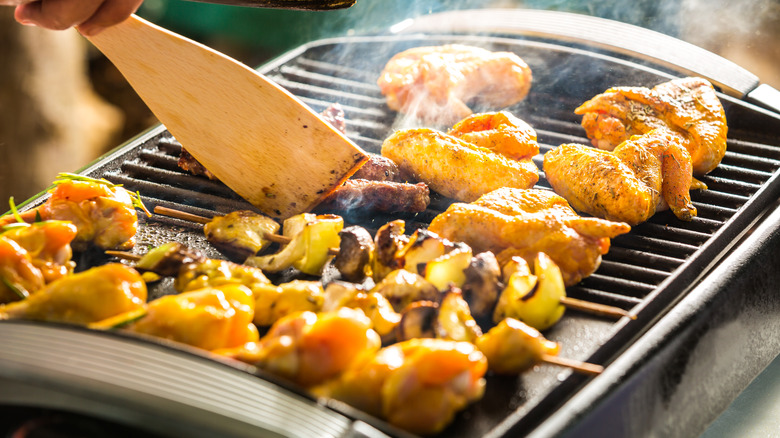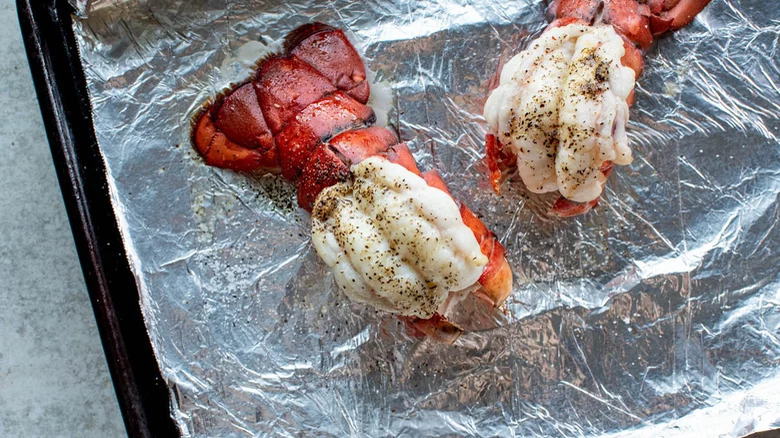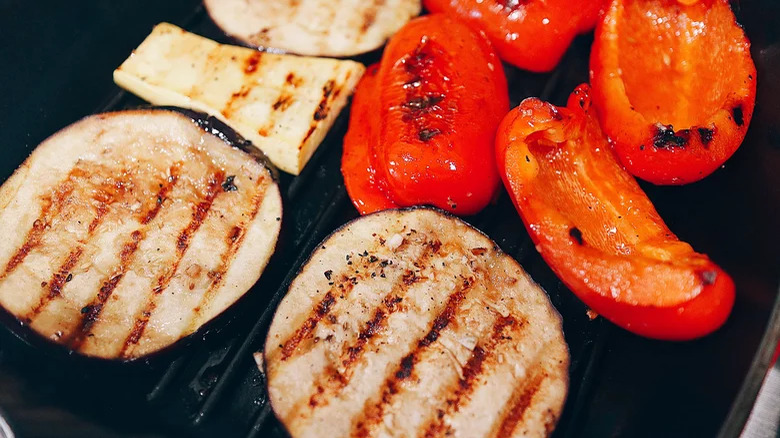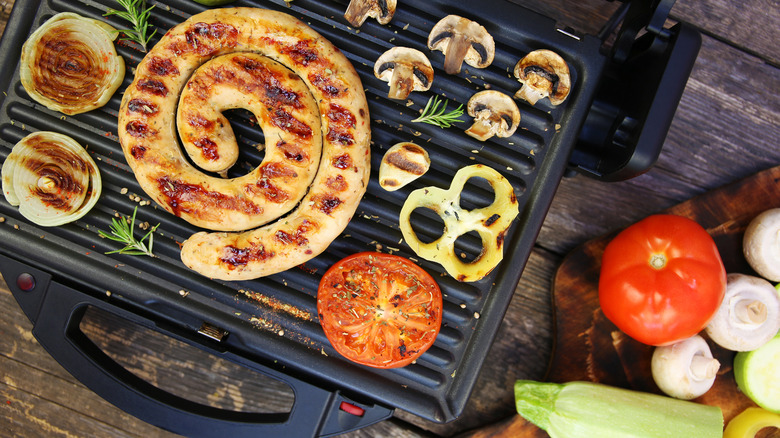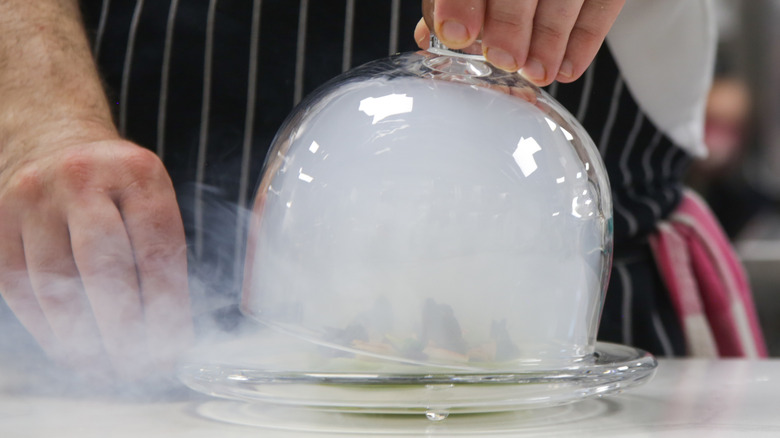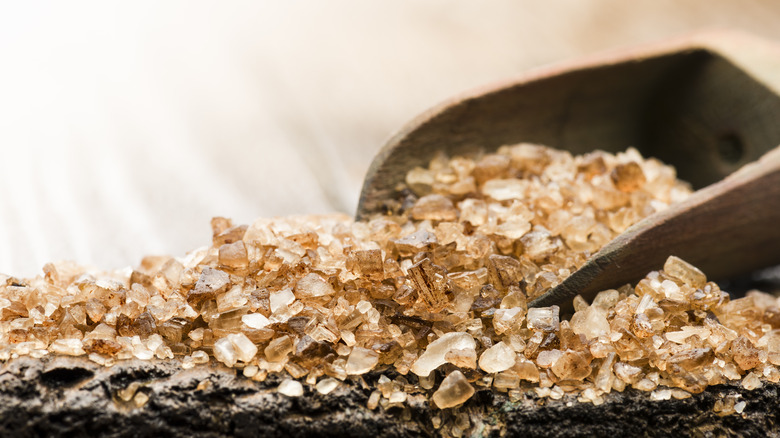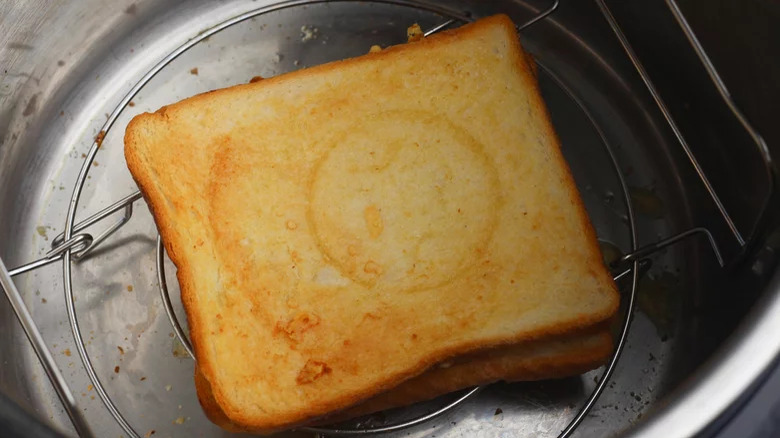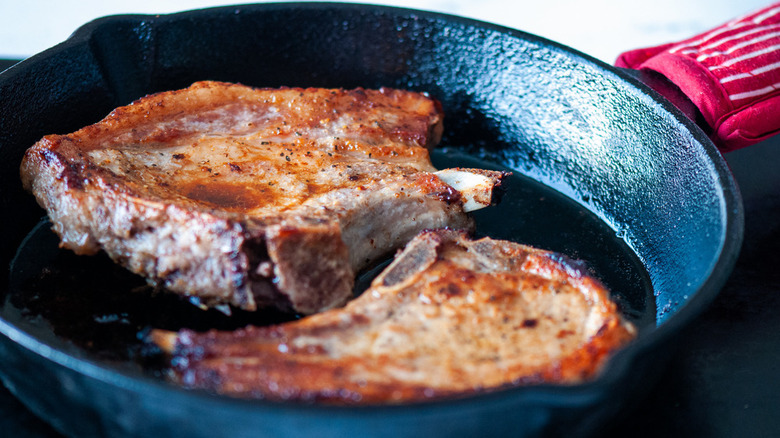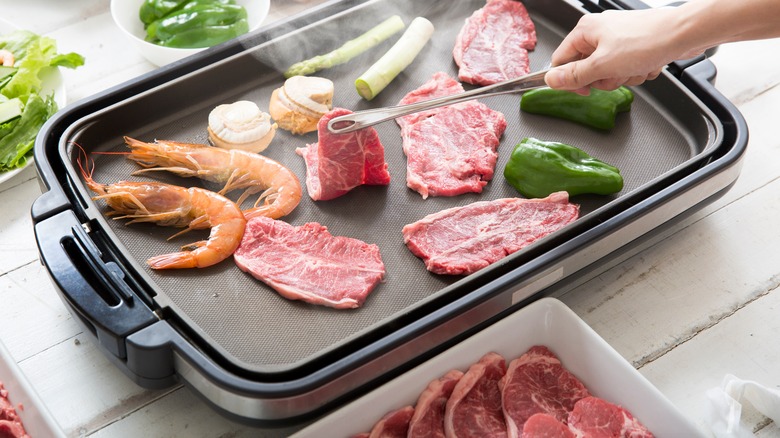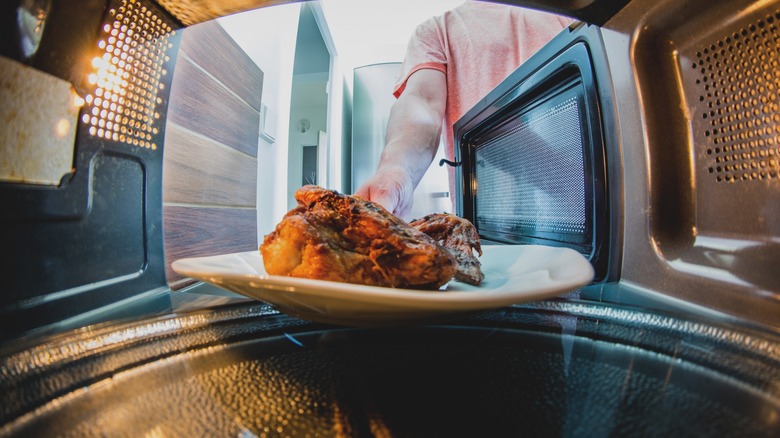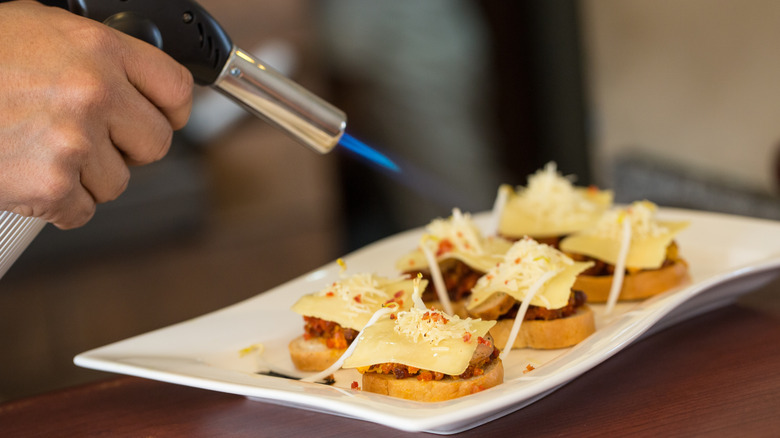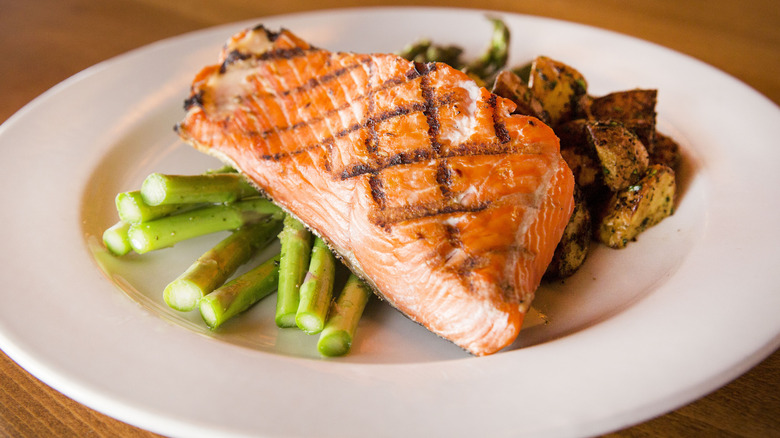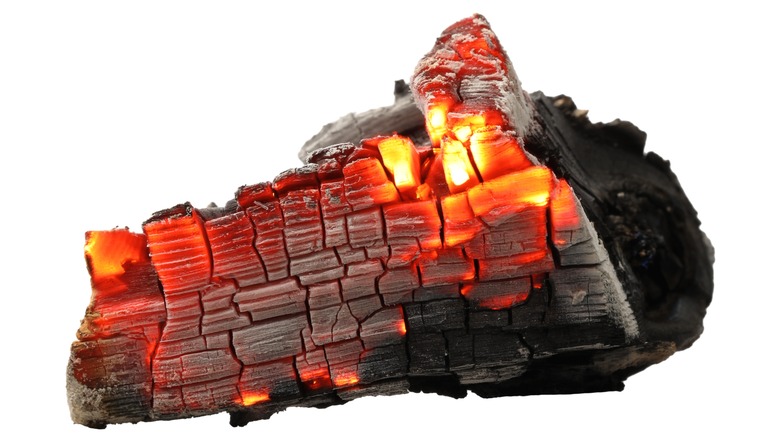The Best Ways To 'Grill' When You Don't Have A Grill
For anyone living in an apartment or a place with minimal outdoor space, cookouts are a no-go. The likelihood is that you don't have a grill either. Even if you do have a grill, it's pretty useless when it's raining or cold outside. It's not exactly tempting to heat up some coals and stand over them shivering. And whether you have a grill or not, do you really want to be grilling burgers outside on a weekday night when you want a no-fuss easy meal? The problem is that you just can't beat that grilled savory taste. Meat that has charred crispy bits and is nice and juicy is the bomb. And grilled veggies elevate any dish, while shrimp are transformed on the barbie. No grill? No problem, you can still enjoy a smoky dish that tastes like a grilled one.
Did you know that there are plenty of simple techniques you can try that replicate that unmistakable grilled taste in the comfort of your indoor kitchen? These are the best ways to "grill" when you don't have a grill.
Grill food under a broiler
Turn grilling on its head with a simple solution: broiling. It works in pretty much the same way, with direct heat grilling your food, except the grill is above and not below. You can pretty much broil anything, from grilled cheese to veggies, fish, and meat. And any morsels that fall through the broiler pan you can easily grab without them being lost to hot coals. And you can add a layer of foil to catch any juices and save on having to scour burnt on run-off.
If your broiler is in your oven, rather than its own special compartment underneath your oven, then be sure to not just set the right temperature, but also adjust the level of the shelves. If whatever you're grilling is fairly close to the heat then you'll get a great grilled flavor. You can simply use the oven rack in place of a grill pan — you'll just need a tray underneath. To enhance the flavor, brush your grilled goodies with oil before grilling. And don't forget to keep the door cracked and keep checking so that you know when to flip your food over and when it's ready. You can butterfly and broil lobster tails in a matter of minutes on the top shelf with a foil-lined tray or grill pan. Brush with melted butter and season before broiling and serving with an herby tarragon compound butter.
Grab a grill pan
One of the simplest ways to grill if you don't have a grill is to grab a grill pan. Because it has ridges, you get those unmistakable grill lines, and because the juices drip into the grooves, whatever you're cooking stays dry and chars. Being able to use a stovetop, rather than wrangle hot coals, means you can easily control the temperature too. When using a grill pan, it's better to cook a thinner steak than you might on an open grill outdoors to ensure the meat will be cooked by the time the exterior is charred. Heat the grill pan before cooking, and if you want cross-hatch grill marks, rotate the food 90 degrees halfway through cooking each side.
If you're cooking a simple grilled swordfish, the fish should come away from the pan easily when it's ready to flip. You can use a grill pan to make a grilled vegetable sandwich with eggplant, zucchini, and red peppers too — grill your ciabatta halves in the pan as well as the vegetables. Cook tender grilled spare ribs in the oven in foil if you don't have a grill. Once you pour over the barbecue sauce, give them a charred edge by finishing them off in a stovetop grill pan. You can put some, but not all, grill pans in the oven too.
Turn on an indoor grill
If you can't go outside to grill, then plug in an indoor electric grill instead. As well as freeing up space on your stovetop, your grill promises to cook whatever you want with signature grill marks. There's something about charred lines that makes your mouth water. And compared to an outdoor barbecue, they are way easier to use. There's no pre-planning necessary and you can start grilling as soon as you turn it on. You don't have to deal with loads of smoke or messing around with dirty charcoal either.
Plenty of indoor grills allow for fats that you don't want sitting there to run off so that the surface is hot and dry. You don't want meats cooking in a ton of grease, especially since grilling in this way can be a healthy way to cook compared to frying. Of course, if you don't have any outdoor space or live somewhere rainy, then that's another reason why you might want to invest in a grill like this. As with any electrical device, you need to follow the safety guidelines, so make sure your grill is on a flat surface when hot. And only clean and store it away once it's cooled down properly. You should find it a lot easier to scrub burnt-on food off your electric grill than to clean a barbecue grate. Of course, if you want a big cookout, then an indoor grill just isn't going to cut it.
Fire up a smoking gun
Every keen home cook loves fancy chef tools, and a kitchen smoking gun hits the target. Not only does it add a smoky aroma to food, but you can create some cool gourmet restaurant-style culinary theatrics with it as well. The key to using this gadget is to do so on food that's already cooked and just needs some smokiness added to it. Cover the food, insert a tube under the cover, and fire up your gun. Wood chips are the source of the smoke, which can really puff out, so you might want to ventilate the area. You can also put herbs and spices in the gun or use it to create your own smoked salt which is great for seasoning meat with a grill-like flavor.
The smoke that hits the food is cool. This means that you can give all types of food a smoky quality, including those that wouldn't be able to withstand the heat of a real grill such as cheeses and delicate fish. If you don't want to buy a smoking gun, you could try making your own smoker instead, with wood chips laid out between sheets of foil in a tray that you can set on direct heat. Add a rack and put your food on it once the smoke starts to appear. Cover the whole assembly with foil to hold the smoke in.
Add smoky seasonings
Grilling is partly about texture. However, you can roast, sear, and air fry veggies and meats so that they have a crispy exterior similar to what you would get on a grill. What really makes a grilled piece of chicken stand out is that classic smoky taste and flavor. And you don't need to fire up a grill to achieve this if you have the right seasonings. Smoked salt gives food a smoky grill essence, and smoked paprika, which is great when used in a dry rub, does the same.
Dried chipotle peppers can be cooked whole or added as a powder to a marinade. To add instant smokiness to a dish, drizzle over some smoked olive oil. Be mindful of not adding too much as the taste can be a little overpowering. Liquid smoke is a classic ingredient, while a lesser-known one for many home cooks might be smoked black cardamon. From dressings to sauces, dips, rubs, and marinades, experimenting with smoky flavors is a culinary adventure.
Use a grill plate in an air fryer
If you're not familiar with how great air fryers are as a healthy alternative to frying, then where have you been? If you're used to using this appliance at home then you'll know how versatile it is. You can pretty much cook anything in them, including our air fryer steak recipe for meat that's tender yet crispy on the outside. The trick to do this is to use parchment paper with holes in it under the meat. This stops the meat from becoming soggy by improving the airflow. A good tip is to heat the air fryer to a fairly high temperature before cooking to achieve that immediate charred effect. Use an oil with a high smoke point and cook meat when it's at room temperature rather than straight from the fridge. You might want to cook a thicker steak than you would on a grill too, since air fryers work incredibly fast.
Grilled cheese also cooks to perfection in an air fryer. You can add the buttered sandwich to the basket with a little oil and let the air fryer do the rest. Your air fryer may come with a specific grill attachment or grill pan that can be easily put in place.
Sear with a cast iron skillet on the stovetop
Every good cook knows that a cast iron pan is essential. Not only can you use it on your stovetop, but you can put it in the oven as well. That means you can sear a beef tenderloin or duck breast on the stove and then cook it through in the oven. Cast iron is great for getting a nicely charred crust on any kind of protein. This is one of the things that's so tasty about grilled goodies.
A major plus-point with a cast iron skillet is that you can sear meat without it sticking. This means you can crank the temperature up and brown a steak, for example, without losing some of that crust to the bottom of the pan. This is what creates that seared, grilled texture and flavor. Once heated to the right temperature the pan stays hot for longer without your stove blasting away, giving you more control. Turn the hood vent on if you're cooking like this, as it's a smoke-filled experience. If you want to boost the browning as you finish your meat in the oven, add a pat or two of butter on top of the meat after taking it off the stove.
Plug in an electric griddle
One of the reasons why burgers always taste better at a restaurant is that they are often sizzled on a hot flat-top griddle. You know how great a smash burger tastes at a diner, right? It can rival a patty that's been cooked on a barbecue grill. You can do this type of cooking in your home kitchen with a portable plug-in griddle. One big advantage of this type of grilling is that the juices from cooking meat don't disappear and fizz on hot coals. They stay on the griddle and add flavor to the mear. You can also grill onions on the flat-top too to soak up the flavor of the meat.
An electric griddle gives you versatility in how you cook and is easy to move around and store. Some electric griddles are combined with a grill plate too, giving you even more grilling options. Certain types of griddles are large enough that they open up, giving you two plates, meaning that you can cook a substantial meal this way. Even so, this option might be better for a dinner for two rather than for a big group looking for hefty portions of grilled meats and fish.
Speed cooking up with a microwave
If you only use your microwave for a quick reheat then you're not alone. However, not all of these handy appliances are the same, and the more sophisticated models do more than just heating cooked food. In fact, some can also grill too. It's really as simple as turning the microwave to grill mode and setting the timer. Just to be clear, grilling in this way doesn't just use microwave energy. Rather it's a combo of microwaves and a conventional heating element, and the grill may use racks that can also be used on the microwave setting too.
Your microwave grill may offer a range of levels of heat. Use whatever utensils you like to get grilled food out, such as tongs. However, if they are not microwave-safe, be extra vigilant that they aren't left inside when the cooker is on. You don't want to be turning on the microwave with anything metal inside. What's super-useful about a microwave grill is that it's a space saver because you're getting two ways of cooking in one device.
Light up a kitchen torch
If you see yourself as something of a culinary artist, one piece of kitchen equipment you definitely need is a blowtorch or kitchen torch. Okay, it might not be a necessity, but it is lots of fun and you'll find that you start to seek out recipes that use one. Crème brûlée anyone? The alternative is to use a broiler, but flaming the top of some custard is much more enjoyable. And it's ideal for giving meat a seared look if you've not cooked it on a grill, maybe because you don't have one.
You might like the succulent, melt-in-the-mouth texture of sous vide steak but want to sear the outside. With a few torch blasts, you can char your steak and add a bit of crusty, carmelized bite that contrasts beautifully with the velvety meat. If you want to create a grilled effect, whether on meat, veggies, or fish, then invest in a powerful torch that can direct a fierce flame. It's best to keep the flame moving and make sure it's nice and blue otherwise it might affect the taste. This hand-held flamethrower can act as an intense broiler and also brings grilling to the table, quite literally. It's great to use at a dinner party in front of guests so you can show off with grill-style theatrics.
Make grill marks with a skewer
"If you can't make it, fake it" is the ethos of this "grilling" tip. Dishes taste better when they look good, and there's something so appetizing about the sight of grill marks branded across a succulent piece of fish. The thought of a crisped-up outside and soft flakes of fish is mouthwatering. But what if you're cooking in an everyday pan or in the oven, surely there's no way you can get that appetite-inducing branding, is there? Actually, there is.
All you need is a metal skewer. Heat this up and then press it down on whatever you're cooking to create those sizzle marks. This is a great trick for kabobs that you want to look grilled. Brand shrimp that you're frying in a pan and then when they are done thread them onto a wooden skewer. Even if you are using a grill pan, this method can enhance the grilled look with shrimp since they are often too small to really show nice grill marks. This way, whatever you're cooking looks as if it's just been thrown on the hot grate of a barbecue in the open air.
Heat up one piece of coal
If you don't have a grill then you may not have any charcoal. But if you have a lump or two then you can definitely find a way to give food a smoky flavor without grilling. This process is called the dhungar method, and it's used in Southeast Asian cuisine. What's great about it is that it's relatively easy to do too. Put the cooked food you want to infuse with smoke into a Dutch oven-style pot and place a small bowl inside on top. You'll still want to be able to fit a lid over everything so keep this in mind. Light a piece of charcoal and when it starts to smolder, place it in the bowl. The magic ingredient to get the smoky reaction is to add some ghee or clarified butter to the charcoal. It'll immediately start to smoke, and this is when you put the lid on top.
This method gives food a smoky, buttery aroma. There aren't any hard and fast rules of how long to smoke dishes for, so it's really a case of trying it for yourself. While you can do this in your kitchen, it's best to head outdoors to light the charcoal until it turns ashy and is ready to put in the bowl. Don't have any charcoal? Just heat up ghee until it smokes in a small pot and use that to perfume your food.
